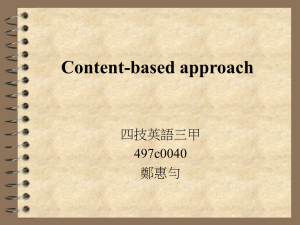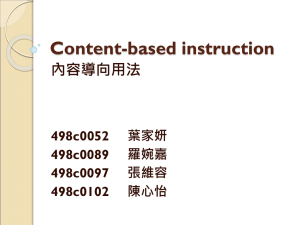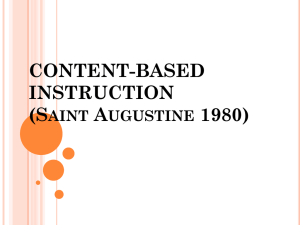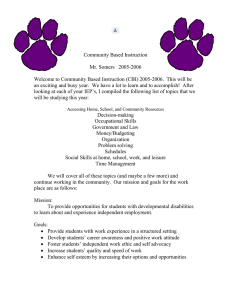Content-Theme-Based Instruction to Increase the Quality of EFL Class
advertisement
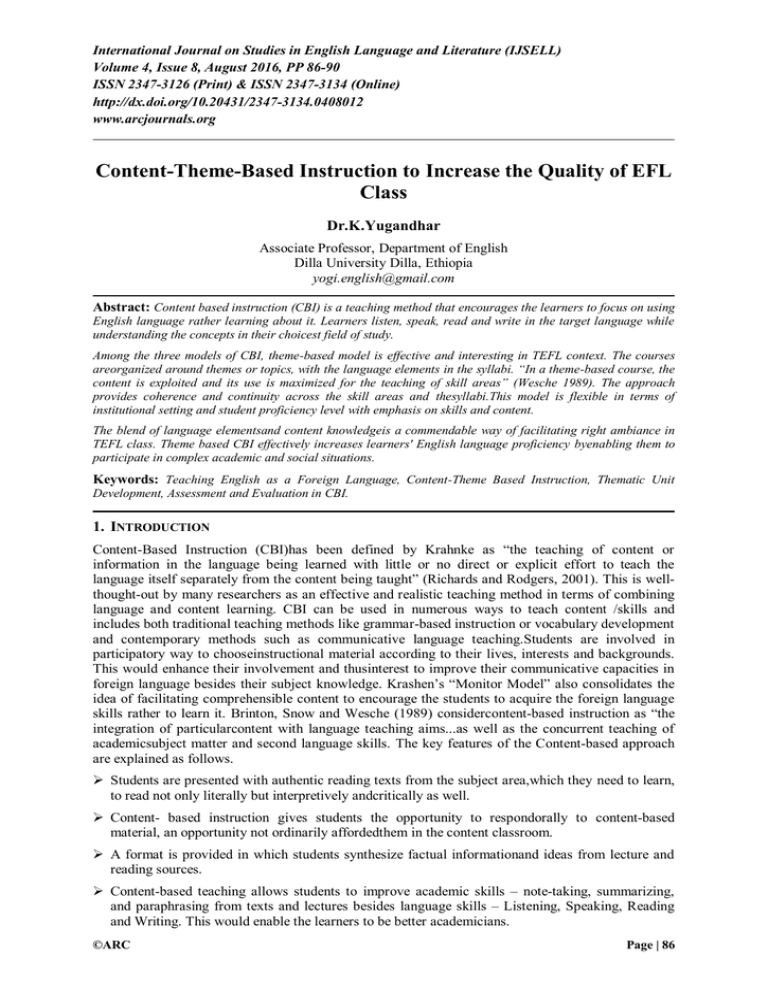
International Journal on Studies in English Language and Literature (IJSELL) Volume 4, Issue 8, August 2016, PP 86-90 ISSN 2347-3126 (Print) & ISSN 2347-3134 (Online) http://dx.doi.org/10.20431/2347-3134.0408012 www.arcjournals.org Content-Theme-Based Instruction to Increase the Quality of EFL Class Dr.K.Yugandhar Associate Professor, Department of English Dilla University Dilla, Ethiopia yogi.english@gmail.com Abstract: Content based instruction (CBI) is a teaching method that encourages the learners to focus on using English language rather learning about it. Learners listen, speak, read and write in the target language while understanding the concepts in their choicest field of study. Among the three models of CBI, theme-based model is effective and interesting in TEFL context. The courses areorganized around themes or topics, with the language elements in the syllabi. “In a theme-based course, the content is exploited and its use is maximized for the teaching of skill areas” (Wesche 1989). The approach provides coherence and continuity across the skill areas and thesyllabi.This model is flexible in terms of institutional setting and student proficiency level with emphasis on skills and content. The blend of language elementsand content knowledgeis a commendable way of facilitating right ambiance in TEFL class. Theme based CBI effectively increases learners' English language proficiency byenabling them to participate in complex academic and social situations. Keywords: Teaching English as a Foreign Language, Content-Theme Based Instruction, Thematic Unit Development, Assessment and Evaluation in CBI. 1. INTRODUCTION Content-Based Instruction (CBI)has been defined by Krahnke as “the teaching of content or information in the language being learned with little or no direct or explicit effort to teach the language itself separately from the content being taught” (Richards and Rodgers, 2001). This is wellthought-out by many researchers as an effective and realistic teaching method in terms of combining language and content learning. CBI can be used in numerous ways to teach content /skills and includes both traditional teaching methods like grammar-based instruction or vocabulary development and contemporary methods such as communicative language teaching.Students are involved in participatory way to chooseinstructional material according to their lives, interests and backgrounds. This would enhance their involvement and thusinterest to improve their communicative capacities in foreign language besides their subject knowledge. Krashen‟s “Monitor Model” also consolidates the idea of facilitating comprehensible content to encourage the students to acquire the foreign language skills rather to learn it. Brinton, Snow and Wesche (1989) considercontent-based instruction as “the integration of particularcontent with language teaching aims...as well as the concurrent teaching of academicsubject matter and second language skills. The key features of the Content-based approach are explained as follows. Students are presented with authentic reading texts from the subject area,which they need to learn, to read not only literally but interpretively andcritically as well. Content- based instruction gives students the opportunity to respondorally to content-based material, an opportunity not ordinarily affordedthem in the content classroom. A format is provided in which students synthesize factual informationand ideas from lecture and reading sources. Content-based teaching allows students to improve academic skills – note-taking, summarizing, and paraphrasing from texts and lectures besides language skills – Listening, Speaking, Reading and Writing. This would enable the learners to be better academicians. ©ARC Page | 86 Dr.K.Yugandhar Krashen (1982) emphasized ways to decrease learner anxiety, such as providing interesting texts as well as meaningful activities, which are comprehensible to learners, and CBI has these essential features: learning a language through academic content, engaging in activities, developing proficiency in academic discourse, fostering the development of effective learning strategies. Thus, this methodology puts emphasis on „learning about something rather than learning about language.‟ 2. CONTENT-THEME-BASED INSTRUCTION Theme-based CBI is effective in EFL class context as the other two models, sheltered and adjunct models, require a partnership of the language teacher with a specialist of the content-area. Further, the primary aim of the two models is to teach a specific subject and specific target vocabulary in some institutional setting. The objective of theme-based CBI model is to advance students‟ language skills regardless of the institutional settings and language proficiency level of the students. Content-theme-based instruction can be taught by an EFL teacher, a content specialist is not arequirement. Classes are planned to teach about a topic in foreign language. Thesyllabus is structured around themes or topics, with the linguistic items in thesyllabus. “In a theme-based course, the content is exploited and its use is maximizedfor the teaching of skill areas.” This model also provides coherence and continuity across the skill areas andthe curriculum. Further,this model is flexible in terms ofinstitutional setting and student proficiency level. The courses are structured around themes or topics, with the language elements in the syllabi. “In a theme-based course, the content is exploited and its use is maximized for the teaching of skill areas” (Wesche 1989). To design a content-theme-based lesson, teachers should consider the students‟ linguistic, strategic, and cultural objectives. Through the class, students are supposed to improve their English skills, to learn strategies to be applied in all subject areas, and to understand the culture of English-speaking people. Moreover, according to Crandall (1999), language instructional models should be consideredwith several features. Thus, the teachers is suggested toconsider the following six issues while using Content-theme-based instruction to improve the subject content and communicative capabilities of his/her students. 1. 2. 3. 4. 5. learning a language by studying of academic text, focusing student attention on underlying knowledge and discourse structures of academic text, developing students‟ learning strategies, focusing on holistic language development through integrated thematic units, developing academic language, skills, and discourse through the use of texts, tasks, and themes drawn from other content areas, 6. focusing on the development of tasks, themes, and topics. Thus, in content-theme-based language instruction, teachers should account for academic concepts and language skills at the same time. Stoller and Grabe suggested Six T-s approach to build coherence in Content-based instruction. These can be successfully adopted in theme based model. Themes: The major ideas around which the units are organized are themes determined by taking students‟ interests, needs and likes, relevance and institutional appropriateness into account. Topics: Subunits of themes are topics. A theme may subsume several topics organized / building one topic on the other arranged in a synchronized manner. Texts: language in classroom is presented in meaningful texts. Stoller and Grabe (1997) claim that … students‟ interest, relevance, and instructional appropriateness, length, coherence, connection to other materials, accessibility, availability, and cost are important. Tasks: Students can develop valuable study skills, such as note-taking, summarizing, and extracting key information from texts through tasks. They may also develop skills in synthesizing, problem solving, and critical thinking. Transitions: Curricular coherence is provided by transitions. Topics and tasks are linked smoothly by transitions. Threads: Another curricular coherence is provided by threads. They are defined by natural linkages across themes. They help students to recycle content, use learning strategies, and to synthesize. International Journal on Studies in English Language and Literature (IJSELL) Page | 87 Content-Theme-Based Instruction to Increase the Quality of EFL Class Content-theme-based language class focuses on the exposure to the synchronized teacher‟s input and peer input and interactions. In such classrooms, students learn through doing and are actively engaged in the learning process. They do not depend on the teacher to direct all learning or to be the source of all information. Accordingly, students assume active, social roles in the classroom that involve interactive learning, negotiation, information gathering and the co-construction of meaning.Thus, it is important for teachers to give students voice, especially in the current educational climate, which is dominated by standardization and testing. 3. CONTENT-THEME-BASED INSTRUCTION IN EFL CLASS The interest in Content-Based Instruction has spread to EFL classroom situations because teachers believe that the language education in EFL contexts should be similar tothat of ESL to some extent. Even though the approachcannot be applied in the same way, an alternative form called “the theme based model” has been introduced in some countries (Davies, 2003). According to Davies, an EFL teacher and a content specialist can teach together for the theme-based CBI, the content is not as limited or specific as in an ESL classroom. Instead of the content that is generally used in ESL, the teacher can design a syllabus that includes broad and varioustopics which students would be interested in, and offer additional supplements from the Internet, newspapers, and other diverse reading sources organized by topics. This model is to teach both the content interested to the particular class and language skills – Listening, Speaking, Reading and Writing. The CBI EFL teachers should care about assessment/ evaluation as much as the ESL teachers. Continuous assessment is needed in CBI and “daily quizzes, journals, and direct oral feedback” can be used (Davies, 2003). Their teaching philosophy is that learners‟ motivation may be highly activated by interesting topics and content and that learners need to enjoylearning. Therefore, theme-based CBI is the best teaching approach for combining language learning and content learning. Teacher-compiled content resources, Teacher-generated content resources, Task-generated content resources, and External content resources are the four basic types of texts are found effective in Theme- based CBI to engage students in improving their content and skills. Texts of various generes, audio, visual materials, Lectures, worksheets, graphic representations, PPT‟s, Manuals, Handouts, Student scripts, discussions, activities, student-gathered materials and Guest speakers by the subject experts, Material from the library and websites would be appropriate material as content resources. This entire procedure is considered as „Thematic Unit Development‟. Six stages of Thematic Unit development are as follows. I. Considering Initial Planning Factors: Language teachers in Theme-based Instruction want to explore meaningfullanguage learning. Earlier to the instructional procedure, some initial planning factors have been considered, like objectives in terms of language and content with appropriate balance between the two. II. Selecting Theme: Students are to be given the chance to opt a theme like „Internet‟ or „transportation‟ or „Communication” to develop their insight into the subject and to sharpen their language skills. Once the theme - A major idea around which the units are organized is chosen, teachers should not bring everything theyknow about the topic to the classroom. III. A Coherent Set of Topics: Then the ambiance conducive to interact with the chosen theme is facilitated by the teacher with suitable instruction and guidelines to expand the theme into a coherent set of topics with apt content and activities. Selecting the most appropriate content resources administered at the beginning of course work has helped to decide on the potential needs of the students. Therefore, some related texts have been developed to support the theme for the students. In the light of these facts, materials, such as cue cards, webs, reading texts and brochures have been classified from easy to difficult. IV. Expanding Theme: Although the students have had a low proficiency level, the instructions are to be given carefully to enable the students to decide on their roles in exploring the information. At first, some anxiety may have been developed because of the lack of comprehension. However, topicrelated vocabulary, and structures have helped them to understand the intended meaning. Moreover, most of the times, the visual representations have been used in order to make meaning clearer. Once the students started to expand the theme use of English language the students would benefit from it. International Journal on Studies in English Language and Literature (IJSELL) Page | 88 Dr.K.Yugandhar V. Monitoring Implementation (Instructional Process): The language skills have been given in an integrated way during the instructional procedure, since Theme-based Content-based language instruction advocates whole language learning. This has been sometimes achieved through the project works, culminating activities and sometimes through the games created. During the theme-based session there has always been created a genuine need to use the language. As a result, the students have provided practice in listening and/or speaking, writing and reading. Another criterion that has made the instructional type used is the emphasis given to cooperative learning. Students are encouraged to work and present their materials in pairs and most of the times in groups. This is to be done through role-plays, discussions and sometimes through materials, one worksheet per group and through roles assigned to them in their group work. Students have been asked to share their information and views with their peers. By this way the students have been provided the chance to learn from their peers and to develop their social skills. Activities / tasks need to encourage students to use their higher order cognitive skills, such as critical thinking, evaluating the given information, making connections, discussing and synthesizing. All these activities have given them the opportunities to see the content knowledge from a variety of sources and a different point of view just as they would do in real life. The culminating activities, graphic organizers and the games used are all helpful in those respects. The students learn how to approach a problem, to decide on the issue, to be creative and productive. The last principle that has been taken into account in theme-based CBI is the emphasis given to meaningful language learning by facilitating various activities, such as workshops, role plays, project-works, and simulations. These would give students concrete experiences in language learning process and opportunities to display newly learnt content in a meaningful and purposeful manner. VI. Evaluation: Then it is about the assessment and evaluation of the entire process.At the end of each topic, both groups havebeen given achievement tests and, at the end of the semester, a final test wasgiven. During the instructional period an integrated skillsapproach has been used. Therefore, the language skills, such as reading and writing aswell as vocabulary and grammar have been given in an integrated way. Theme based CBI EFL class encourages the students to interact with their choicest subject information and to sharpen his/her language/ communicative abilities. The incentives of the theme based class are - autonomy, spirit of learning and using the language, acquiring the ability at one‟s own pace and the spontaneous feedback during the activities makes the learning faster. Once the learners are involved in self-study from the very beginning of the course work with suitable content in conducive class climate, they can prepare simple projects which require the minimum of the language knowledge. They become accustomed to self-dependence and responsibility for their education. 4. EVALUATION IN CONTENT-THEME-BASED INSTRUCTION EFL CLASS Evaluationin CBI EFL class can be a problematic component, and yet it is critical that instructors evaluate students‟ learning. Student performance in most EFL classes is evaluated by general assessmenttasks such as “discrete, decontextualized tasks,” and their main focus is on linguistic structure or vocabulary. However, students in CBI classes cannot be evaluated in the traditional way because they were exposed to more input and content information through the class. According to Kasper (2000), “designing authentic and interactive content-based assessment” was required because learners in CBI had to “complete discourse level tasks” and the skills evaluated in the assessment were in an academic setting. Students are required to interact critically with academic materials in terms of meaningful and contextualized text to analyze their knowledge. Assessment of CBI should not be simple and isolated; students must be required “to integrate information, to form, and to articulate their own opinions about the subject matter,” not to analyze the linguistic structure of the target language. Crandall (1999) also mentioned that it would be impossible for teachers to „separate conceptual understanding from linguistic proficiency‟ in CBI when they want to evaluate students‟ learning. With that thought, he suggested that teachers could make assessment of students‟ learning through “paper and pencil tests to include journal entries, oral responses to questions or reports, demonstrations of understanding, and student projects.” In addition, “checklists or inventories” can be used toassess language development: it may show each student‟s mastery of the lesson including concepts and structure. These methods have been developed as alternative strategies to assess students‟ learning. International Journal on Studies in English Language and Literature (IJSELL) Page | 89 Content-Theme-Based Instruction to Increase the Quality of EFL Class 5. CONCLUSION Content-theme-based instruction is interesting, interactive and enthusiastic, as the themes are chosen by the students and interact with the information to use it in the classroom. Students are given the opportunity to take information from diverse sources to use after, re-evaluating and restructuring. Students learn better through theme-based CBI as they are said to havedeveloped a much wider knowledge of the world through information gap activities,graphic organizers problem solving activities, sequencing and ranking activities under the guidelines of their teacher.Because of the inclusion of pair andgroup work during the classwork, the students develop collaborative and cooperative learning skills. Further, Relevantcontent selection has enabled the students to use language in a moremeaningful way, to review the content for different purposes, and also to plan the topics. This integration of theme-based content with the language learning seems appropriate and enables the students familiar with both the context of learning content and learning language. Collaborative activities are useful for the students to brainstorm and generate the ideas for their writing and comprehend the reading texts at the first stage of academic skills learning. Thus, the Content-ThemeBased Instructioneffectively increases learners' English language proficiency by enabling them to participate in complex academic and social situations. REFERENCES Brinton, D. M.A. Snow, and M.B. Wesche. 1989. Content-based second languageinstruction. New York: Newburry House Publishers. Crandall, J. A. (1992). Content-centered instruction in the United States. Annual Review of Applied Linguistics, 13, 111-126. Davies, S. 2003. “Content-based instruction in EFL contexts”. The Internet TESLJournal, Vol. IV, No. 2, February 2003, http://iteslj.org. Kasper, L. (2000). Content-based college ESL instruction. Mahwah, NJ: Lawrence Erlbaum. Kinsella, K. (1997). Moving from comprehensible input to "learning to learn" in CBI. In M. A. Snow & D. Brinton (Eds.), The content-based classroom: Perspectives on integrating language and content (pp. 46-57). White Plains, NY: Longman. Krashen, S. (1982). Principles and practice in second language acquisition. Oxford, UK: Pergamon. Richards, J., & Rodgers, T. (2001). Approaches and methods in language teaching. New York: Cambridge University Press. Snow, M., & Brinton, D. (1988). Content based language instruction: Investigating the effectiveness of the adjunct model. TESOL Quarterly, 22(4). Stoller, F. L. And W. Grabe. 1997. “A six T‟s approach to content-based instruction”. InContentbased Classroom perspectives on integrating language and content(Eds.). M. A. Snow & D. M. Brinton. New York: Longman. AUTHOR’S BIOGRAPHY Dr.K.Yugandhar, Associate Professor of English, has received Ph.D. in English from Jawaharlal Nehru Technological University, Hyderabad, India. He has been teaching English language and literature to graduate and post graduate students for the past eighteen years. Most of his research work focuses on interlacing technology with pedagogical concepts to improve the quality of Education in general and English Language Teaching in particular. He received credentials in ELT from Osmania University, Andhra University, Kakatiya University and Central Institute of English and Foreign Language, Andhra Pradesh, India. International Journal on Studies in English Language and Literature (IJSELL) Page | 90

